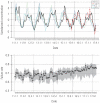Association between in vitro fertilization success rate and ambient air pollution: a possible explanation of within-year variation of in vitro fertilization success rate
- PMID: 31970130
- PMCID: PMC6962578
- DOI: 10.5468/ogs.2020.63.1.72
Association between in vitro fertilization success rate and ambient air pollution: a possible explanation of within-year variation of in vitro fertilization success rate
Abstract
Objective: To evaluate patterns in air pollution concentrations and in vitro fertilization (IVF) success rates using data from a large, long-term clinical database.
Methods: We conducted a retrospective cohort study investigating South Korean women who pursued IVF and embryo transfer (IVF-ET) between 2011 and 2017. Hourly concentrations of air pollutants measured at 318 air quality monitoring sites in South Korea between 2011 and 2017 were obtained from the National Institute of Environmental Research. Monthly trends in pregnancy rates and concentrations of air pollutants were assessed.
Results: A total of 34,427 IVF-ET cycles in 18,478 patients were analyzed. The mean age of women at the time of IVF-ET was 36.6 years. The clinical pregnancy rate in the IVF-ET cycle was 30%. Analysis of pregnancy failure rates by month showed that IVF-ET failure rates tended to be higher in March and April and lower in July and August. Concentrations of air pollutants including particulate matter (PM) less than 10 μm in diameter, PM less than 2.5 μm in diameter, sulfur dioxide, nitrogen dioxide, and carbon monoxide were highest in March and April and lowest between July and September.
Conclusion: Within-year variations were similar between IVF-ET failure rates and air pollution concentrations based on analysis of a large, long-term database. Specifically, IVF-ET success rates were highest when PM concentrations were lowest. Further studies are warranted to examine the mechanisms accounting for the association between IVF success and air pollutant exposure.
Keywords: Air pollution; In vitro fertilization; Particulate matter; Pregnancy rate.
Copyright © 2020 Korean Society of Obstetrics and Gynecology.
Conflict of interest statement
Conflict of interest: No potential conflict of interest relevant to this article was reported.
Figures


Similar articles
-
Association between ambient air pollution and pregnancy rate in women who underwent IVF.Hum Reprod. 2018 Jun 1;33(6):1071-1078. doi: 10.1093/humrep/dey076. Hum Reprod. 2018. PMID: 29659826
-
Association between outdoor air pollution during in vitro culture and the outcomes of frozen-thawed embryo transfer.Hum Reprod. 2019 Mar 1;34(3):441-451. doi: 10.1093/humrep/dey386. Hum Reprod. 2019. PMID: 30689907
-
Association between ambient air pollution and pregnancy outcomes in patients undergoing in vitro fertilization in Shanghai, China: A retrospective cohort study.Environ Int. 2021 Mar;148:106377. doi: 10.1016/j.envint.2021.106377. Epub 2021 Jan 19. Environ Int. 2021. PMID: 33482441
-
Guidelines for the number of embryos to transfer following in vitro fertilization No. 182, September 2006.Int J Gynaecol Obstet. 2008 Aug;102(2):203-16. doi: 10.1016/j.ijgo.2008.01.007. Int J Gynaecol Obstet. 2008. PMID: 18773532 Review.
-
[Breathing: Ambient Air Pollution and Health - Part II].Pneumologie. 2019 Jun;73(6):347-373. doi: 10.1055/a-0895-6494. Epub 2019 Jun 11. Pneumologie. 2019. PMID: 31185518 Review. German.
Cited by
-
Fine particulate matter and ovarian health: A review of emerging risks.Heliyon. 2024 Nov 19;10(22):e40503. doi: 10.1016/j.heliyon.2024.e40503. eCollection 2024 Nov 30. Heliyon. 2024. PMID: 39650185 Free PMC article. Review.
-
The introduction to air pollution on pregnancy outcome (APPO) study: a multicenter cohort study.Obstet Gynecol Sci. 2023 May;66(3):169-180. doi: 10.5468/ogs.22278. Epub 2023 Mar 27. Obstet Gynecol Sci. 2023. PMID: 36973177 Free PMC article.
-
Observed Effects on Very Early Pregnancy Linked to Ambient PM2.5 Exposure in China among Women Undergoing In Vitro Fertilization-Embryo Transfer.Environ Health (Wash). 2024 Oct 21;2(12):918-928. doi: 10.1021/envhealth.4c00107. eCollection 2024 Dec 20. Environ Health (Wash). 2024. PMID: 39722841 Free PMC article.
-
How Can Outdoor Air Pollutants Adversely Affect the Women's Fertility? Systematic Review.Adv Biomed Res. 2024 Nov 30;13:115. doi: 10.4103/abr.abr_45_24. eCollection 2024. Adv Biomed Res. 2024. PMID: 39717257 Free PMC article. Review.
-
Environmental Factors Involved in Maternal Morbidity and Mortality.J Womens Health (Larchmt). 2021 Feb;30(2):245-252. doi: 10.1089/jwh.2020.8855. Epub 2020 Nov 18. J Womens Health (Larchmt). 2021. PMID: 33211615 Free PMC article.
References
-
- European Environment Agency. Air quality in Europe—2014 report [Internet] Luxembourg: Publications Office of the European Union; c2014. Available from: https://www.eea.europa.eu/publications/air-quality-in-europe-2014.
-
- Cosselman KE, Navas-Acien A, Kaufman JD. Environmental factors in cardiovascular disease. Nat Rev Cardiol. 2015;12:627–642. - PubMed
-
- Karakis I, Kordysh E, Lahav T, Bolotin A, Glazer Y, Vardi H, et al. Life prevalence of upper respiratory tract diseases and asthma among children residing in rural area near a regional industrial park: cross-sectional study. Rural Remote Health. 2009;9:1092. - PubMed
LinkOut - more resources
Full Text Sources
Miscellaneous

